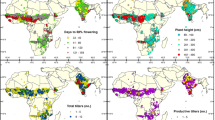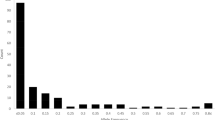Abstract
ICRISAT conserves a large collection of pearl millet [Pennisetum glaucum L. R. (Br.)] comprising of 21,392 accessions. This includes landraces, cultivars, genetic stocks, breeding lines, and wild relatives from 50 countries. However, only a small fraction of this huge collection has been exhaustively used in the pearl millet improvement program. The objective of our research was to develop a core collection of pearl millet to enhance utilization of genetic resources in improvement programs and simplify their management. For this purpose, accessions were initially stratified according to geographical distribution followed by hierarchical clustering on 11 quantitative traits using Ward’s method. This resulted in 25 distinct groups. Approximately 10% accessions were then randomly selected from each of these 25 distinct groups to form a core collection of 1,600 accessions. Different statistical methods like comparison of mean using Newman–Keuls test, variance using Levene’s test, frequency distributions using Chi-square test, and Wilcoxon’s rank-sum non-parametric test for the traits validated that the variation present in entire collection had been preserved in the core collection. The important phenotypic correlations among different traits that may be under the control of co-adapted gene complexes were also preserved in the core collection. The diversity represented in the core collection will therefore, be a guideline to breeders for a wider use of the pearl millet genetic resources available in the genebank.

Similar content being viewed by others
References
Appa Rao S, Mengesha MH, Sibale PK, Rajagopal Reddy C (1986) Collection and evaluation of pearl millet (Pennisetum) germplasm from Malawi. Eco Bot 40(1):27–37
Basigalup DH, Barnes DK, Stucker RE (1995) Development of a core collection for perennial Medicago plant introductions. Crop Sci 35:1163–1168
Bataillon TM, David JL, Schoen DJ (1996) Neutral genetic markers and conservation genetics: simulated germplasm collections. Genetics 144:409–417
Brown AHD, Grace JP, Speer SS (1987) Designation of a core collection of perennial Glycine. Soybean Genet Newslett 14:59–70
Brown AHD (1989a) Core collections: a practical approach to genetic resources management. Genome 31:818–824
Brown AHD (1989b) The case for core collections. In: Brown AHD, Frankel OH, Marshall DR, Williams JT (eds) The use of plant genetic resources. Cambridge University Press, Cambridge, UK, pp 136–156
Crossa J (1989) Methodologies for estimating the sample size required for genetic conservation of outbreeding crops. Theor Appl Genet 77:153–161
Dalrymple DG (1986) Development and spread of high-yielding wheat varieties in developing countries, 7th edn. US Agency for International Development, Washington DC
Diwan N, Bauchan GR, McIntosh MS (1994) A core collection for the United States annual Medicago germplasm collections. Crop Sci 34:279–285
Dowswell CR, Paliwal RL, Cantrell RL (1996) Maize in the third world. Westview Press, Boulder, USA
Erskine WA, Muehlbauer FJ (1991) Allozyme and morphological variability, outcrossing rate and core collectionformation in lentil germplasm. Theor Appl Genet 83:119–125
FAOSTAT (2005) http://apps.fao.org/
Frankel OH (1984) Genetic perspective of germplasm conservation. In: Arber W, Llimensee K, Peacock WJ, Starlinger P (eds) Genetic manipulations: impact on man and society. Cambridge University Press, Cambridge, England, pp 161–170
Frankel OH, Brown AHD (1984) Plant genetic resources today: a critical appraisal. In: Holden JHW, Williams JT (eds) Crop genetic resources: conservation and evaluation. George Allen and Unwin, London, UK, pp 249–257
Grenier C, Bramel-cox PJ, Hamon P (2001) Core collection of sorghum: I. Stratification based on eco-geographic data. Crop Sci 41:234–240
Harlan JR, de Wet JMJ (1971) Towards a relational classification of cultivated plants. Taxon 20(4):509–517
Holbrook CC, Anderson WF, Pittman RN (1993) Selection of a core collection from the U.S. germplasm collection of peanut. Crop Sci 33:859–861
Huaman Z, Aguilar C, Ortiz R (1999) Selecting a Peruvian sweetpotato core collection on the basis of morphological, eco-geographical, disease and pest reaction data. Theor Appl Genet 98:840–844
Huaman Z, Ortiz R, Zhang D, Rodriguez F (2000) Isozyme analysis of entire and core collections of Solanum tuberosum subsp. andigena potato cultivars. Crop Sci 40:273–276
Jiang HF, Duan NX (1998) Utilization of groundnut germplasm resources in breeding programme. Crop Genet Resour 2:24–25
Keuls M (1952) The use of the “Studentized range” in connection with an analysis of variance. Euphytica 1:112–122
Khairwal IS, Rai KN, Andrews DJ, Harinarayana G (1999) Pearl millet breeding. Oxford & IBH publishing Co. Pvt. Ltd., New Delhi, 506 pp
Levene H (1960) Robust tests for equality of variances. In: Olkin I (ed) Contributions to probability and statistics: essays in honor of Harold Hotelling. Stanford University Press, Stanford, pp 278–292
Mahajan RK, Bisht IS, Agarwal RC, Rana RS (1996) Studies on South Asian okra collection: methodology for establishing a representative core set using characterization data. Genet Res Crop Evol 43:249–255
Malosetti M, Abadie T (2001) Sampling strategy to develop a core collection of Uruguayan maize landraces based on morphological traits. Genet Res Crop Evol 48(4):381–390
Milligan GW, Cooper M (1985) An examination of procedures for determining the number of clusters in a data set. Psychometrika 50(2):159–179
Newman D (1939) The distribution of range in samples from a normal population expressed in terms of an independent estimate of standard deviation. Biometrika 31:20–30
Ortiz R, Ruia-Tapia EN, Mijica-Sanchez A (1998) Sampling strategy for a core collection of Peruvian Quinoa germplasm. Theor Appl Genet 96:475–483
Ortiz R, Madsen S, Ruiz-Tapia EN, Jacobsen SE, Mujica-Sanchez A, Christiansen JL, Stolen O (1999) Validating a core collection of Peruvian Quinoa germplasm. Genet Res Crop Evol 46:285–290
Prasada Rao KE, Ramanath Rao V (1995) The use of characterization data in developing a core collection of sorghum. In: Hodgkin T, Brown AHD, van Hintum MJL, Morales EAV (eds) Core collections of plant genetic resources. A Wiley-Sayee Publications, Chichester, UK, pp 109–116
Reddy LJ, Upadhyaya HD, Gowda CLL, Singh S (2005) Development of core collection in pigeonpea [Cajanus cajan (L.) Millspaugh] using geographic and qualitative descriptors. Genet Res Crop Evol 52:1049–1056
Romesburg HC (1984) Cluster analysis for researchers. Lifetime Learning Publ., Belmont, CA
SAS Institute (1989) SAS user’s guide: statistics. State University Press, Cary, NC, USA
Schoen DJ, Brown AHD (1993) Conservation of allelic richness in wild crop relatives is aided by assessment of genetic markers. Proc Natl Acad Sci USA 90:10623–10627
Shannon CE, Weaver W (1949) The mathematical theory of communication. University of Illinois Press, Urbana, USA
Shiv Kumar S, Gupta S, Chandra S, Singh BB (2004) How wide is genetic base of pulse crops? In: Ali M, Singh BB, Shiv Kumar S, Dhar V (eds) Pulses in new perspective. Proceedings of the National Symposium on Crop Diversification and Natural Resources Management, 20–22 December 2003. Indian Society of Pulses Research and Development, Indian Institute of Pulses Research, Kanpur, pp 211–221
Skinner DZ, Bauchan GR, Auricht G, Hughes S (1999) Developing core collections for a large annual Medicago collection. In: Johnson RC, Hodgkin T (eds), Core collections for today and tomorrow. International Plant Genetic Resources Institute, Rome, Italy
Spagnoletti-Zeuli PL, Qualset CO (1993) Evaluation of five strategies for obtaining a core subset from a large genetic resource collection of durum wheat. Theor Appl Genet 87:295–304
Taba S, Diaz J, Franco J, Crossa J (1998) Evaluation of Caribbean maize accessions to develop a core subset. Crop Sci 38:1378–1386
Tohme J, Jones P, Beebe S, Iwanga M (1995) The combined use of agro-ecological and characterization data to establish the CIAT Phaseolus vulgaris core collection. In: Hodgkin T, Brown AHD, van Hintum MJL, Morales EAV (eds) Core collections of plant genetic resources. A Wiley-Sayee Publications, Chichester, UK, pp 95–107
Upadhyaya HD, Bramel PJ, Singh S (2001) Development of a chickpea core subset using geographical distribution and quantitative traits. Crop Sci 41:206–210
Upadhyaya HD, Ortiz R, Bramel PJ, Singh S (2003) Development of a groundnut core collection using taxonomical, geographical, and morphological descriptors. Genet Resour Crop Evol 50:139–148
Upadhyaya HD, Furman BJ, Dwivedi SL, Udupa SM, Gowda CLL, Baum M, Crouch JH, Buhariwalla HK, Singh S (2006) Development of a composite collection for mining germplasm possessing allelic variation for beneficial traits in chickpea. Plant Genet Resour 4:13–19
Vellve R (1992) Saving the seed: genetic diversity and European agriculture. Earthscan Publications, London
Ward JH (1963) Hierarchical grouping to optimize an objective function. J Am Stat Assoc 58:236
Wilcoxon F (1945) Individual comparisons by ranking methods. Biom Bull 1:80–83
Acknowledgements
The lead author gratefully acknowledges ICRISAT for granting a research fellowship during her doctoral program and also for funding the project.
Author information
Authors and Affiliations
Corresponding author
Rights and permissions
About this article
Cite this article
Bhattacharjee, R., Khairwal, I.S., Bramel, P.J. et al. Establishment of a pearl millet [Pennisetum glaucum (L.) R. Br.] core collection based on geographical distribution and quantitative traits. Euphytica 155, 35–45 (2007). https://doi.org/10.1007/s10681-006-9298-x
Received:
Accepted:
Published:
Issue Date:
DOI: https://doi.org/10.1007/s10681-006-9298-x




